July - Episode 1
Welcome to the first of my offerings for July (The next batch will be posted on the 19th.)
So what’s coming up this time?
We have:
· my Pollinator Plant of the Month
· we’re taking a look at St Swithin’s Day
· some jobs to be getting on with
· nature notes – and a piece of music
So without further ado, here’s my Pollinator Plant of the Month
Lavender’s Blue, Dilly Dilly ….
No, I’m not taking up folk singing (thank goodness, I hear my musical friends cry!), rather it seemed a good title for my article on lavender (Lavandula sp.).
I can’t remember a time when I haven’t grown lavender. Even when I lived in flat and the only ‘garden’ I had was a window box, I forsook all other plants and was faithful to my lavender. And it was my all-time favourite that I grew: L. angustifolia ‘Hidcote’. Cultivated by Lawrence Johnston, owner of Hidcote Manor in the Cotswolds until the late 1940s, it has become, arguably, the best-known, and best loved, of all the English lavenders.
So lavender is native to England, then? Actually no, although it’s been growing here for centuries. All species of lavender are native to areas such as the Middle East, southern and central Europe, north Africa and south-west Asia. It’s thought that it was introduced to Britain by the Romans, although the first written reference to it doesn’t appear until 1265.
We do know that Gerard in his 16th century Herbal advocates lavender as a help for ‘them that have the Catalepsy, a light migram, and to them that have the falling sicknesse […] panting and passion of the heart, giddinesse, turning, or swimming of the braine’. Queen Elizabeth I carried posies of lavender and other sweet-smelling herbs to reduce the effect of unpleasant smells (stench more like). It has also been used in tussie mussies, or posies, the flowers of which carried particular meanings: lavender can mean constancy and devotion, but it can also mean distrust!
In addition, the flowers were used extensively for culinary purposes throughout the centuries: apparently Queen Victoria liked lavender jelly rather than mint with her lamb. I love lavender scones (made with a plain sweet scone mixture with a pinch of lavender flowers) eaten with home-made lemon curd and clotted cream – yum.
Lavender really came into its own in England in the 19th century when the hardiest of the lavenders, Lavandula angustifolia, began to be grown on a commercial scale for its essential oil, used in the perfume industry. In fact, the product was so consistently good that perfumiers (even French ones) would specify that they wanted English lavender – and, apparently, that’s how Lavandula angustifolia came to be known as English lavender.
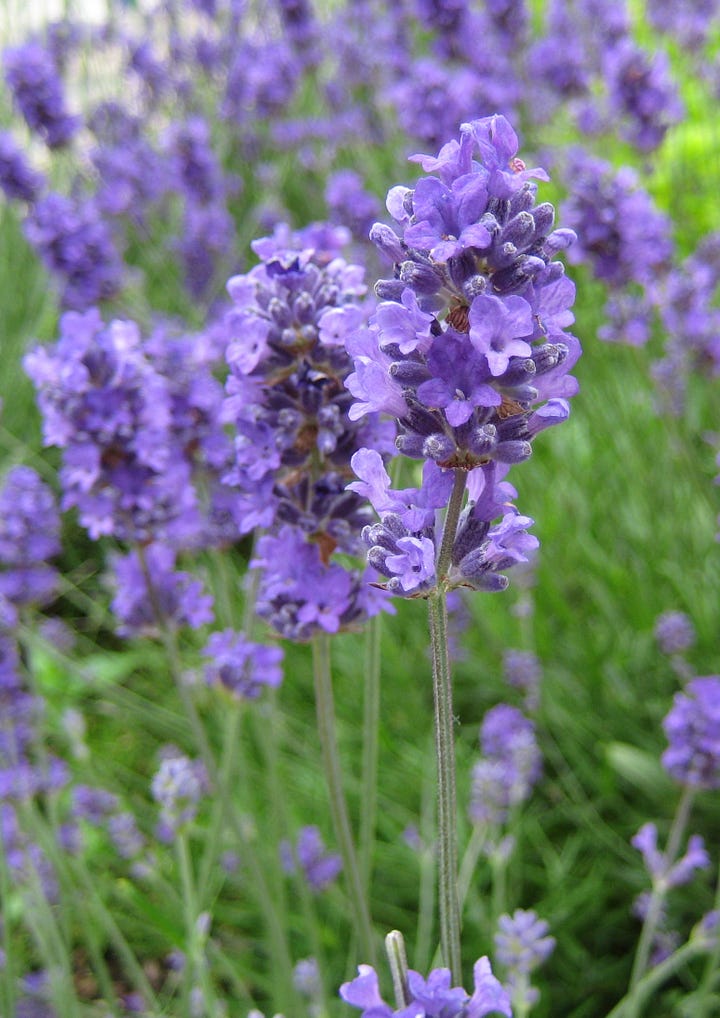
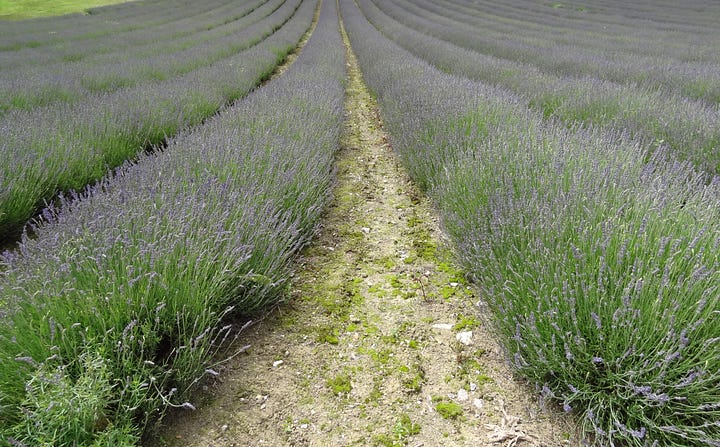
Commercial production in Britain waxed and waned, and is now waxing again and you can visit numerous lavender farms that open their gates to the general public.
But back to my window box. All lavenders need the sun with really free-draining, verging on poor, soil which is what I could give them in my container. In the garden it can be a bit trickier to meet these optimum requirements, but fall short and your lavender with sulk and give up the ghost. If you want to keep them overwinter you need to grow the hardiest types, namely L. angustifolia or L. x intermedia (the latter is a hybrid of L. angustifolia subsp angustifolia and L. latifolia) Both are hardy in the UK to -15˚C.
But which variety to choose? In one nursery catalogue there were no less than 18 varieties of L. x intermedia, and 30 of L. angustifolia. So, let’s think about criteria: what colour – there are white and pink as well as lavender-coloured; how tall – some reach 90cm, others just 40cm; decisions, decisions. The one decision you won’t have to make, however, is which ones are best for bees, because all varieties of L. angustifolia and L. x intermedia are, although some appear more attractive than others.
The University of Sussex carried out research in 2014 about which plants are best for bees. (The results were published in Functional Ecology Volume 28, pages 364–374, but I don’t think the bees will have changed their minds much over that period of time.) They focussed on Lavender in particular and trialled 6 each of L. angustifolia and L. x intermedia, all of which were readily available at nurseries. Of the six varieties of L. angustifolia, ‘Hidcote’ and ‘Folgate’ were the most popular with bees, and ‘Edelweiss’ and ‘Gros Bleu’ were the favoured varieties of L. x intermedia. (See below)
Interestingly, lavender attracts more bumble bees than honeybees. There is a particular reason for this which is related to the length of the bees’ proboscis (the hollow tongue through which they gather the nectar) and the depth of the lavenders’ corolla tube (the fused petals of the individual flower which are shaped like a tube). The length of a honeybee’s proboscis is approximately 2mm shorter (at 6.6mm) than that of bumblebees (7.8 - 8.9mm) which means that bumblebees can more readily access the bottom of the corolla tube (approximately 7mm) where the nectar is to be found.
In addition, it was found that bumblebees extracted the nectar more quickly than honeybees, therefore being able to visit more flowers in the same given time.
So, it seems that the poor little honeybee is being outcompeted by their longer-tongued cousins. But don’t despair, honeybees will still visit, even though they will be outnumbered – they can’t resist the nectar.
Let’s have a quick look at the bees’ favourite varieties now.
First L. angustifolia ‘Hidcote’. This is a dark purple variety with grey foliage which grows to about 50cm. Be sure to get your plants from a reputable source – there are an awful lot of imposters out there!
Second is L. angustifolia ‘Folgate’. This variety has ‘bluer’ flowers than ‘Hidcote’, with slightly greener foliage, It grows to about 60cm.
Third is L. x intermedia ‘Edelweiss’. As its name suggests this is a white variety; it grows to about 75cm forming a domed bush, so allow it plenty of space.
Last is L. x intermedia ‘Gros Bleu’. This is an introduction from France, which, colour-wise, is similar to ‘Hidcote’. It’s taller than ‘Hidcote’, though, growing to about 75cm
And now it’s time for tea in my favourite mug, featuring lavender - and bees, of course!
I’m getting a bit ahead of myself but in 10 days’ time it’s
Saint Swithin’s Day.
There’s a traditional poem that goes:
St Swithin's day if thou dost rain / For forty days it will remain / St Swithin's day if thou be fair / For forty days 'twill rain no more.
So from the 15th July, St Swithun’s Day until 2nd August, it’s either going to chuck it down non-stop, or we’re in for a drought.
Legend has it that Swithin, (or Swithun) a first century Bishop of Winchester asked to be buried in a simple tomb outside - ‘where the sweet rain of heaven may fall upon my grave’ – rather than within the Cathedral. His wish was granted until some years later when his remains were moved inside. Then the heavens opened and it rained … and rained … and rained… which gave rise to the saying about 40 days of weather.
How likely is it that it will be rain – or indeed stay fine – for that length of time? According to weather records which have been kept since 1861, it’s highly unlikely: there hasn’t been a record of 40 consecutive wet or dry days from 15th July onwards since those records began.
Even so, it got me thinking about the two extremes and what plants could possibly cope with either of those scenarios. Here, then, are my top St Swithin’s Plants – 5 wet-tolerant, and 5 drought-tolerant.
First the wet-tolerant, so we’re talking moist all the time with these.
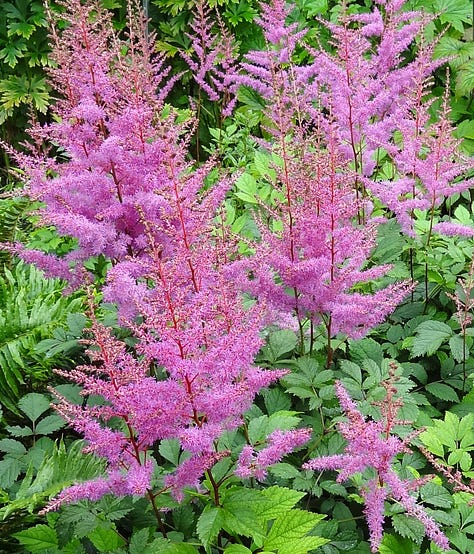
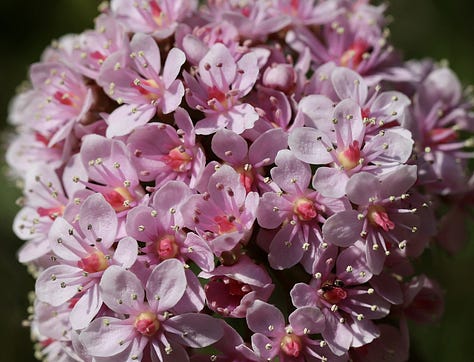
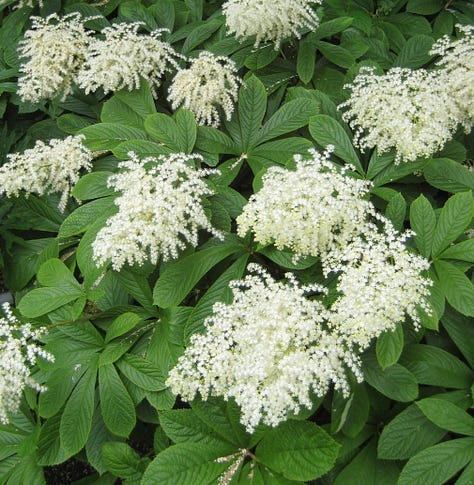

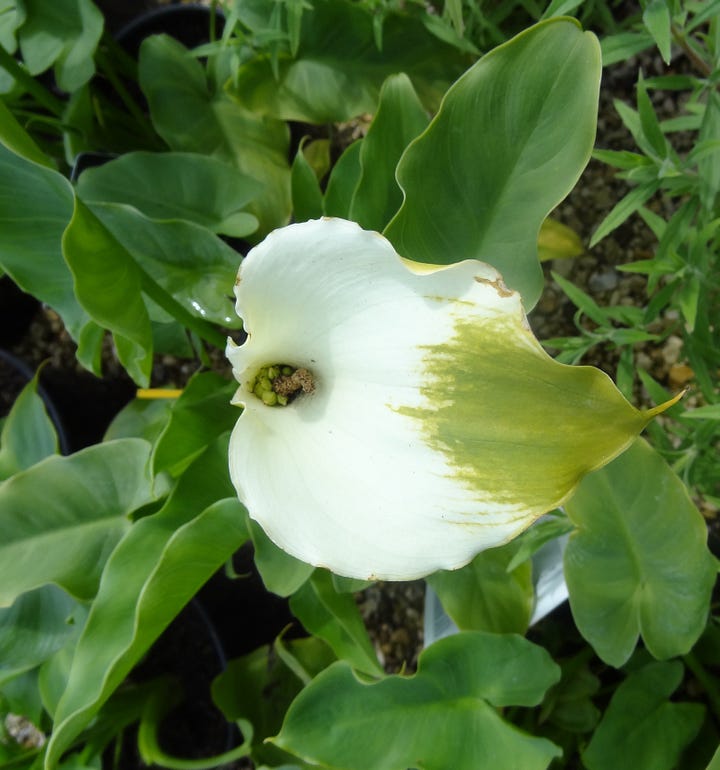
My first plant that doesn’t mind moisture is Astilbe. Astilbe are actually one of the few perennial plants that actually thrive in shady and moist conditions. Some varieties will grow up to a metre with a spread of about 50cm, making a striking focal point and brightening up a dull, wet corner. I love the foamy sprays of flowers which are also good for cutting. I particularly like A. arendsii ‘Amethyst’ (pictured), introduced by German nurseryman Georg Arends in the early 20th century
My second plant that doesn’t need an umbrella is actually called the Umbrella Plant – it’s Darmera peltata. The umbrella bit relates to its leaves which can have a span of 45cm, and the plant itself can reach 1.5m, so you really do need a bit of room for this specimen. The architectural leaves can make a real statement in a bog garden, poorly drained areas or riparian locations, but it’s the flowers, which appear in late spring before the leaves that I particularly like. Each globe, atop stems of varying height, has clusters of star-shaped pink flowers – beautiful. Darmera will grow in full sun but most people seem to have better success in part-shade. Either way, the most important thing is to keep the soil moist.
Next comes Filipendula. F. ulmaria is the native meadowsweet or meadwort, referring to its use as a flavouring for mead or beer. My beekeeping friend makes mead but I have yet to persuade him to use some meadowsweet in it – in the past, meadowsweet was used for stomach complaints, so I don’t think it would do much harm. We’ll see. Other species of Filipendula have found their way into the garden, too: F. palmata (see picture) has lovely palmate leaves, and F. rubra, known as ‘Queen of the Prairies’, can cope with a drier environment. All species can cope with sun or part-shade.
My fourth plant is an Iris. Not the statuesque bearded iris which require free-draining soil and baking sun, no, this is Iris siberica which needs really moisture-retentive soil and can cope with part-shade. Although I. sibirica are clump-forming, they can multiply at a sometimes alarming rate if they feel at home: they will settle down and stretch out and before you know it they have occupied the space next to it that you had allocated for something else – in much the same way as our cat, Phoebe, takes up residence on the whole of the settee. Unlike bearded iris the falls and standards of I. sibirica flowers tend to be of the same colour, and the majority are blue, purple (like I. siberica ‘Percheron’, pictured), yellow, white and occasionally pink.
My final wet-tolerant plant is Zantedeschia. You have to be careful which species you choose, however, because not all can withstand the moist conditions that I’m forcing upon them. We need Z. aethiopica which - despite its appearance which makes it look as if it would be more at home in the tropics - is hardy throughout most of the UK, according to the RHS. I’m not going to argue with this because I used to grow Z. aethiopica ‘Green Goddess’ (pictured), which survived a Lancashire winter with very little attention. It will grow to about a metre in height with a spread of roughly 60cm, and can cope with sun or part-shade.
Well, that was the wet-feet brigade, let’s turn now to five plants that need just the opposite.
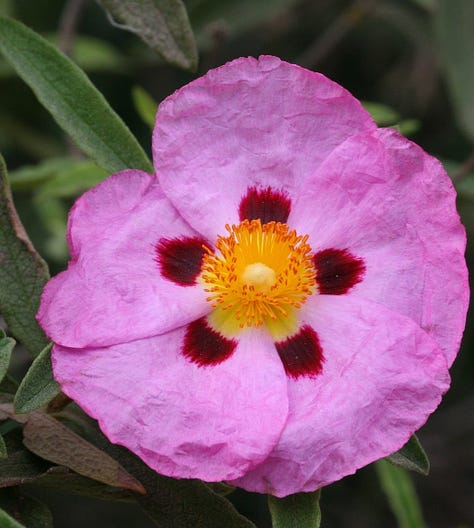
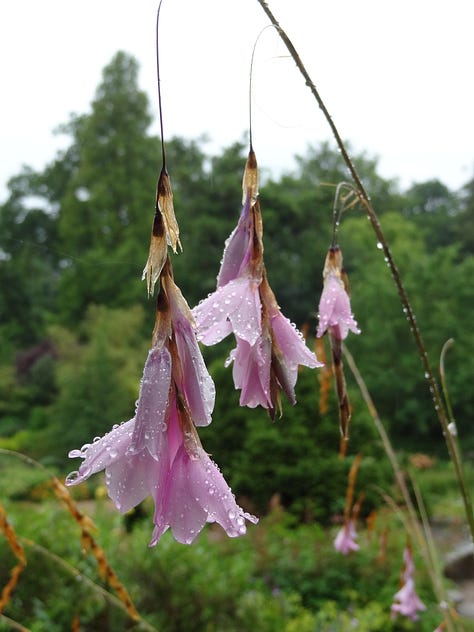

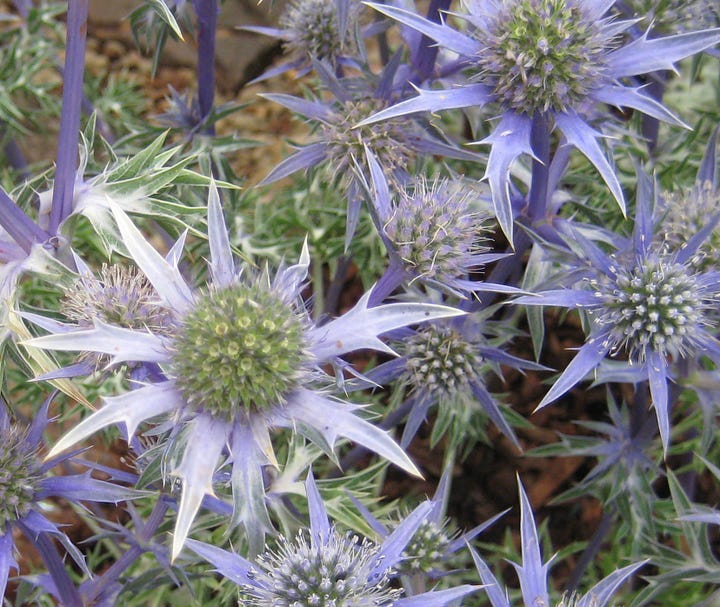
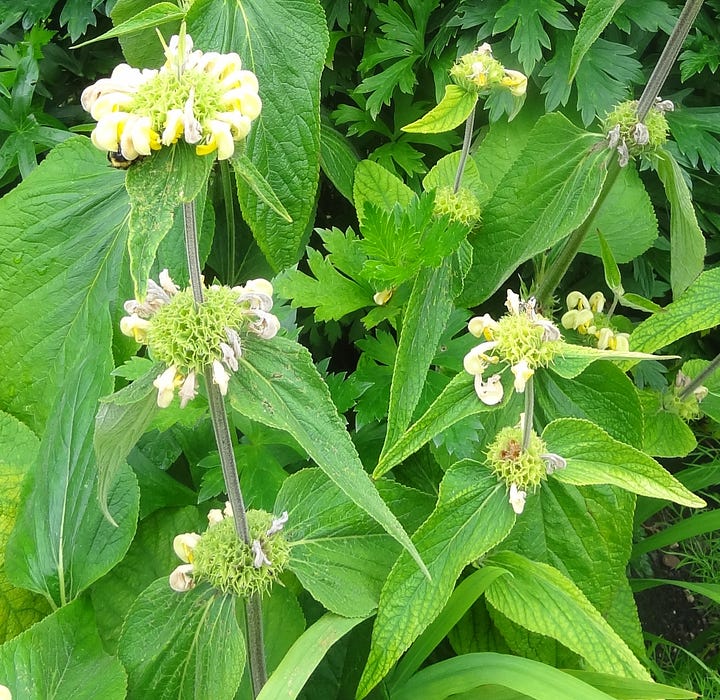
My first is Cistus. Hailing from dry, stony areas across the Mediterranean and the Canary Islands, these gems are drought-tolerant – in fact they need free-draining soil to thrive. There are over 20 species of this shrub but unfortunately, the majority of them are not hardy and will struggle in anything but a mild winter. You can easily take softwood cuttings from them in summer, however, keeping the plants in a frost-free spot over winter so you have some replacement plants just in case the parent plant doesn’t survive.
Plant them in full sun and you will have a beautiful display of open, single rose-like flowers (hence it’s common name of rock rose) all summer long. When they’ve finished flowering trim them back to keep a pleasing shape, but don’t prune them hard.
My second drought-tolerant plant is Dierama, or Angel’s fishing rods. Given its common name, many people assume that it actually prefers a water-side location with damp conditions. Nothing could be further from the truth – give it that sort of environment and it will mope and before long give up the ghost. Having said that, when I came across Dierama looking the best I’d ever seen it, it was growing in full sun alongside a min-water cascade – the important bit was that it was growing in almost rock-garden-like conditions with very free-draining soil. Soil is the key – that, and not disturbing them too much. Try and move them and they will sulk. This makes propagation a little tricky, as the only way to guarantee true offspring is by dividing the parent plant. You can grow Dierama from seed, but it is a little hit-and-miss as to what you will get and you will have to be patient because they will take at least three years before they are ready to flower. Far better is to buy a named cultivar from the garden centre nursery – some of the most spectacular introductions have been from Jim Cave in Cornwall, with his varieties named after Camelot characters: D. ‘Merlin’, D. ‘Guinevere’ and D. ‘Lancelot’. Depending on the variety, they’ll grow up to 1.2m with a spread of about 50cm – imagine a large group with their pendulous flowers swaying in the breeze – heavenly.
Third comes Erigeron. In many ways Erigeron are early versions of Michaelmas daisies – they have similar daisy-like flowers with yellow centres and they are also good for pollinating insects. The picture is of E. ‘Sommerabend’ – see what I mean about Michaelmas daisies? Given the popularity of Michaelmas daisies, I’m surprised that Erigeron are not more widely grown. Perhaps it has something to do with its common name, Fleabane, which, less face it, has a less than attractive ring to it. However, as its common name implies it is valuable for repelling fleas and other unwanted insects – a virtue that is not in such great demand these days but proved to be very useful before the advent of insecticides. Like my other drought-tolerant plants it needs free-draining soil and sun. Growing to about 60cm with a spread of 45cm or so, it would fit in almost any garden given the right conditions.
Fourth is Eryngium. I think if you were to try and describe an Eryngium to someone who had not seen one, and then went on to say that it is a popular garden plant, you would be looked at in amazement, nay, incredulity! Its thistle-y form and the almost surreal, electric-blue colour of the stems and flowers of some varieties almost defy description, and yet it has established itself as one of the stalwarts of the perennial border. This is perhaps partly due to the fact that there are a couple of British natives, including E. maritimum - from which we get the common name of sea holly - which have been cultivated over the years. The common name sea holly tells us the sort of conditions it likes – very free-draining, almost sand-like soil.
There are dozens of different species of Eryngium - all are spectacular in their own way, but I particularly like E. x bourgatii ‘Picos Amethyst’ (pictured).
Finally, there is Phlomis. I do think Phlomis is one of the unsung heroes of the perennial border. They’re statuesque, have an interesting form, provide whorls of blooms throughout the summer and, if you leave the tidying up until spring, you benefit from the faded, but still attractive, stems during the winter. They’re drought-tolerant, love a sunny position and are pretty-well trouble-free – oh, and bees love them too. I don’t think we need many more reasons to grow them.
So there we have my St. Swithun’s Day hit parade. I have a feeling that we’ll actually need plants that fall somewhere between to two extremes of wet and dry – but that’s for another article.
Now here are just a few …
Jobs for July
Cut lavender for drying. Choose newly opened flowers - they have the strongest fragrance - then hang up in a cool, dark place.
Prune shrubs that flowered in late spring and early summer.
Continue to deadhead flowers to encourage more blooms.
Water plants in containers judiciously.
Take semi-ripe cuttings from shrubs and sub-shrubs, such as lavender.
Plant autumn-flowering bulbs, such as Colchicum (autumn crocus), Sternbergia, Nerine, and Hesperantha.
Harvest new potatoes, onions and garlic.
Nature Notes
As well as being a gardener, I also used to keep bees until a back injury brought it to an end. Most of the time I couldn’t decide if I was gardening beekeeper or a beekeeping gardener (it depended on what I was doing at the time, I think) - either way both activities have a place in my heart for two reasons.
Firstly, they both provided me with food for my body in the shape of fruit and vegetables, and honey.
Secondly, and more importantly, when I was tending my garden or the bees, they provided food for my soul and allowed me instances of utter contentment that no material goods could ever afford.
This was brought home to me on one occasion when I was helping a friend check a number of his hives which were on a rape crop. It was a beautiful summer’s day, and the bees were contented, buzzing around collecting nectar and pollen and not at all disturbed by my presence. I paused before moving on to the next hive, taking a deep breath and savouring the moment. Then another sound layered itself above the buzzing of the bees.
A skylark had begun its heart-lifting song, reaching ever higher. All else melted away: it was just me, the bees, the skylark - and a privileged glimpse of heaven on earth. I know that both gardeners and beekeepers alike will be nodding in acknowledgement.
Music
I wish I had had a recording device so that I could relive that moment just as it happened. Instead, I recreate it by listening to one of the most evocative pieces of classical music ever written. The Lark Ascending by Ralph Vaughan Williams.
Written in 1914, but not performed until 1920 the piece was inspired by a poem of 1881 with the same title by George Meredith. In the poem are the lines:
He rises and begins to round,
He drops the silver chain of sound,
Of many links without a break,
In chirrup, whistle, slur and shake.
No wonder Vaughan Williams was moved to create a musical interpretation. But he goes further than that. The composer's second wife, Ursula, herself a poet, wrote that her husband had "taken a literary idea on which to build his musical thought … and had made the violin become both the bird's song and its flight, being, rather than illustrating the poem from which the title was taken".
This piece isn’t just a beautiful evocation of nature, its graceful melodies and delicate harmonies also speak of a universal longing for stillness, freedom, and spiritual elevation.
I’ll leave it there, and encourage you to listen to the piece in its entirety (there are many performances available on YouTube). If you have never listened to it before, I can pretty well guarantee you’ll lose yourself in the music and glimpse in your own mind’s eye a little piece of heaven on earth.
Picture credits: Skylark - Pixabay; All others - my own copyright.






